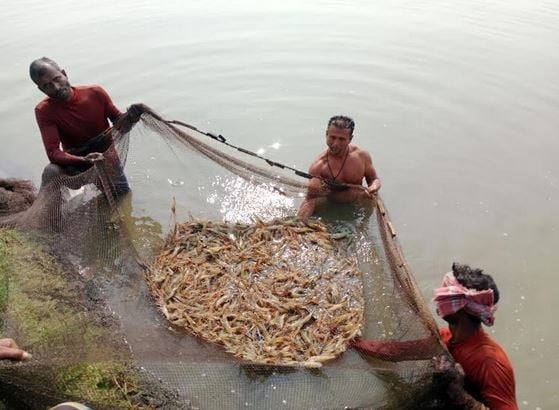News Flash
News Flash

KHULNA, Jan 27, 2025 (BSS) - Adverse impact of climate change has been posing
a threat to the shrimp farming as the impacts are reducing the number of wild
prawn broodstock in the region for the last couple of years.
Along the coastal areas, livelihoods based on shrimp, fish and rice
cultivation face growing risks from climate change-induced sea level rise,
extreme flooding, cyclones, erosion and salinization.
Dr Aksya Kumar Sarkar, 25-year experienced in shrimp production, processing
and marketing, told BSS that prawn feeding, breeding and nursery grounds are
vulnerable in the region.
Producers and exporters are worried about falling production of shrimps,
affecting exports from the region, for hurdles mainly stemming from climate-
induced changes in temperature.
In the country's southwest region, prawn culture remains largely dependent on
wild post larvae as the hatchery production is limited and farmers consider
the wild post larvae of higher quality.
Referring to the biological and ecological aspects Dr Aksya Sarkar said
prawns are strongly linked to the salinity of water.
Prawns require brackish water in the initial stages of their life cycles and
therefore are found in water that is directly or indirectly connected to the
sea. Prawn postlarvae use estuaries to find shelter and food.
Production of export-oriented freshwater prawns is a key industry that is
vulnerable to climate change. The coastal areas extensively used for prawn
farming in Bagerhat, Khulna and Satkhira districts have been impacted by
floods, heavy rains, droughts, cyclones and tidal surges.
Large number of poor coastal residents engaged in fishing for prawn post
larvae near the Sundarbans. However, their catches have been declining due to
increased water temperature and salinity as a result of climate change.
Extreme weather events such as cyclones, floods and droughts and rising sea
levels could further change the aquatic ecosystem and increase the scarcity
of wild postlarvae.
Coastal fishing communities face a double exposure of reduced post larvae
stocks and increased risks of coastal flooding and storm surges.
Talking to BSS here, Praful Kumar Sarkar, a shrimp expert and former
fisheries officer, said poor prawn farmers and associated groups are often
socially, economically and politically marginalized and have worse access to
health, education and other social services.
Availability of postlarvae has been reduced in the coastal villages that
depend heavily on prawn farming. Adverse impact of climate change has been
causing the loss of prawn feeding, breeding and nursery grounds in the
Sundarbans.
In the region, prawn farming is currently one of the most important sectors
of the national economy. The prawn is a highly valued product for
international markets with almost all prawns exported to the United States
and Europe.
Praful Kumar Sarkar said the country would lose a significant amount of
foreign currency earnings if prawn production decreased due to climate
change.
Besides, reduced production would affect other prawn-related activities,
including hatchery operations, prawn feed industries and prawn processing.
Climate change presents a particular challenge to the sustainability of the
prawn sector. Research in this area needs to be given particular attention,
considering existing prawn-farming technology and the development of
community-based adaptation measures.
He said increased salinity in inland groundwater has already been observed in
recent years. Salinity ingress increases soil salinity and reduces soil
fertility. It could also lead to reduced rice and freshwater fish production
and limit biodiversity and wildlife.
Dr Mostafa Sarwar, a noted climate expert and Head of the department of Urban
and Regional Planning at Khulna University of Science and Technology (KUET),
said there are opportunities to reduce the potential vulnerability through
promoting coping strategies and improving adaptability.
Integrated coastal zone management and forestation in coastal areas could
reduce potential economic losses.
Effective climate action should be just, equitable, and centre the voices of
people who are disproportionately affected by climate change.
Using shrimp aquaculture as a climate change solution was a top-down approach
shaped by the existing systems of power and resource distribution.
Dr Mostafa Sarwar said there is a difference between mature shrimps and their
minnows regarding heat enduring capacity. Minnows can't grow naturally in
high water temperatures.
Farmers release minnows to their enclosures in January-February when water
temperature remains around 25 degrees Celsius.
In March, water temperature rises to 27 degrees Celsius, which kills a large
portion of the minnows.
Mostafa added that rising water temperature is also responsible for viral
infections.
Golam Kibria Ripon, General Secretary of Shrimp Fry Trading Association, also
said that salinity in the rivers in Khulna has become a major headache.
"Usually the water in the rivers of Khulna region becomes saline in January.
Last year, salinity of the rivers was delayed to February.
Lack of saline water during the harvesting period is affecting shrimp
farming badly," he said. "Although the rate of salinity used to be 16-18 ppt
in May-June period, it has come down to 8-10 ppt nowadays."
A shrimp farmer in the Daulatpur area of Khulna said there is not sufficient
water in water bodies for shrimp production. Along with this, there is always
an outbreak of virus attacks, he added.